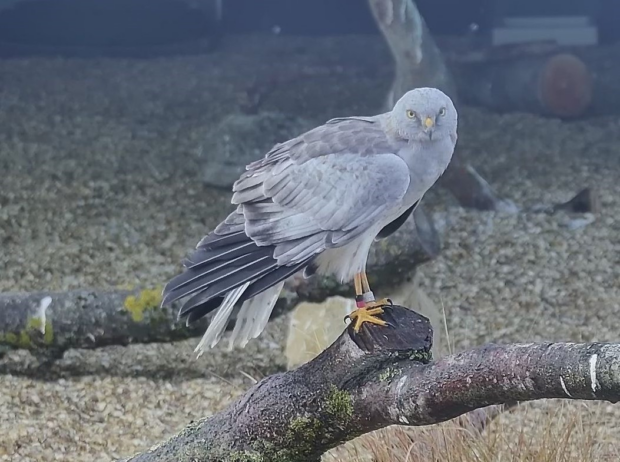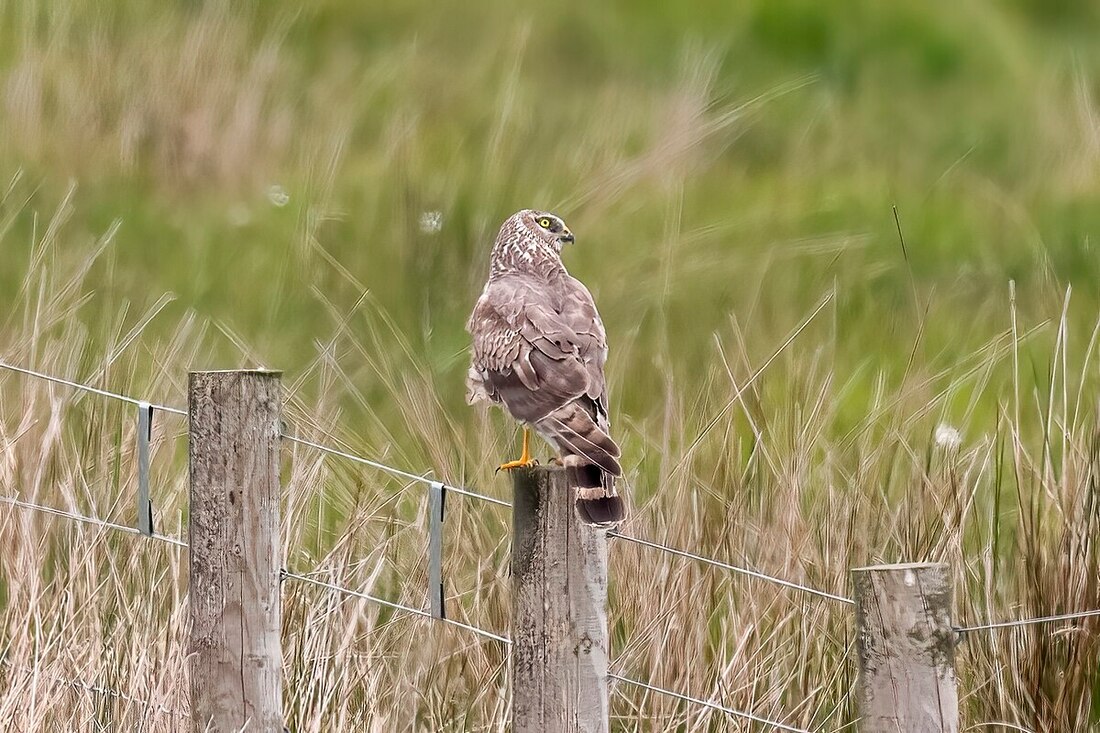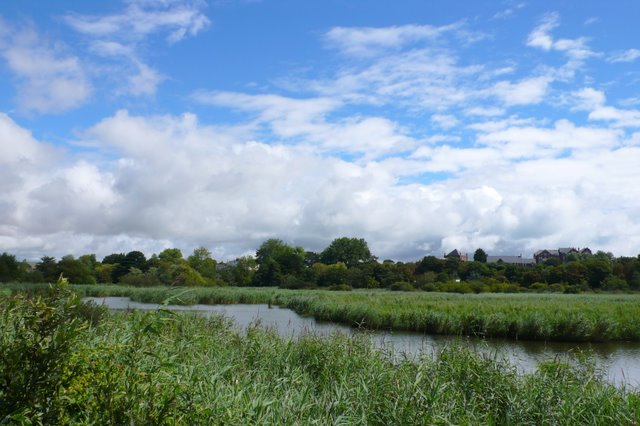|
I love to hear skylarks singing on sunny days above the downs and the fields around Tisbury. It must be one of our most well-known birds, as there must be few who do not recognise its song, delivered from high in the sky. An inspiration to artists, poets and composers, the skylark is often easier to hear than see, and when on the ground, its drab inconspicuous plumage can make it difficult to spot. It may only be up close that you can spot its distinctive crest, which clearly separates it from the somewhat similar, but less stocky, meadow pipit, which has a far less exuberant song.
Although there is a good handful of lark species to be found on the continent, there is just one other that you might see in the UK, the rarer woodlark. This is a bird of the heaths, so the best place to look for them near here would be in the New Forest. Slightly smaller than the skylark, with a short tail that makes it look a bit like a bat when in flight, the woodlark shares the same brown streaky plumage as the skylark. The plumage of larks and pipits provides effective camouflage for the birds when feeding and nesting on the ground. This is a common adaptation for ground nesting birds and serves well to protect them from conventional predators. Unfortunately, it does little to protect them from challenges brought by the loss of stubbles, and other changes to agricultural practices. Numbers have dropped by 15% over the last 30 years and the bird is now Red Listed in the UK. Ground nesting birds are particularly vulnerable to straying dogs. This is one of the reasons why the Countryside Code makes it a legal requirement to have your dog on a lead on open access land between 1 March and 31 July, and under effective control for the rest of the year. Responsible pet owners will help our endangered birds to have a successful breeding season. Andrew Graham Mike Read is a wildlife photographer and he (and his wife) have spent many hours traversing the Somerset Levels recording the flora and fauna of this ancient land. For over 5,000 years, people have visited this area. Bordered by the sea at Bridgewater Bay, receiving the rain run-offs from the Mendips, Quantocks and Blackdown Hills, and being the flood plains of several low gradient rivers (the River Parrett, for example, declines by 11.5 inches over a stretch of 11 miles) the water levels are now more controlled than in ancient times and a variety of nature conservation organisations manage the land to support and encourage a wide and varied array of wildlife.
Having set out the parameters of the area, Mike introduced us to an ancient walkway, said to date from 3806 BCE precisely! This raised boardwalk was known to our ancestors as the Sweet Track and helped them to navigate their way through the reeds and vegetation, above the water while hunting and gathering their food and resources. Peat continues to be cut from the nutrient rich soils and reeds harvested for use in basket making and for thatch. Mike’s favourite product of the area is the apples used in cider making and having been drunk by everyone instead of the unclean water. Our talk started with a photograph of a telegraph pole with a curious carving of a bird on top. The bird was a dalmatian pelican. Remains of this species have been found preserved in the peat and so they must have lived there. We were treated to a selection of superb photographs of the Somerset Levels through the seasons, starting with spring and alder catkins, marsh marigold, lapwings, 6 species of heron, egrets, marsh harrier, peregrine, the heronry at Swale Wood (visited by several members last spring), the early nesting mistle thrush while it’s cousin, the song thrush, is still singing to attract a mate, and the first migrants, chiff chaff and blackcaps. Nestled down in the reeds, we saw images of bittern and then a series of shots of great crested grebe doing a cat display followed by a weed dance, all part of their courtship rituals. The number of curlews has increased since the nature bodies have had a say in the optimum level of the water. The first butterflies and dragonflies were photographed among the water lilies and iris while a hobby was captured with a dragonfly in its beak. In summer, the bees are swarming and the yellow and white flowers of spring are superseded by the darker, richer colours of great willowherb, purple loosestrife and tufted vetch. Swallows arrive and the great egret chicks fledge. Kingfisher, moorhens, mallards and others are hunted by buzzards and marsh harriers. Towards the end of the summer, apples ripen, ditches are cleared and migrants pass through including the whitethroat and osprey. Hops, hips, elderberries and blackberries glisten in the autumn sunshine and provide food for speckled wood and red admirals. Fungi appears including fairy ink caps and glistening ink caps. Flocks of lapwing grow in number day by day. Golden plover arrive from the northern UK and Iceland. Mike told us about the successful reintroduction programme of the common crane and how many pairs are now breeding on the levels and some pairs have moved away to South Wales. In winter, lapwings, golden plovers, black-tailed gobwits and cormorants can be seen and wetland fowl of all kinds will be displaying and wing flapping in order to attract a mate. During the winter months, it is the best time to see bearded tits, short-eared owls and barn owls and also the now world famous murmurations of starlings. All captured through Mike’s lens and accompanied by interesting and amusing anecdotes, we are eagerly anticipating our visit to the levels this summer. The society’s visit to Ham Wall is on Saturday June 8th, 2024. Emma Procter Our next meeting, at the Victoria Hall on Tisbury High Street on Thursday 14th March at 7:30pm (doors, and the bar will be open from 7:00) will hear from Mike Read who is going to share with us his view of ‘The land of the Somer people’.
Mike, who lives at Ringwood in Hampshire, has worked as a free-lance wildlife photographer for over 40 years. His pictures are often used as nature illustrations, including in books he has written or co-authored such as 'The Robin' & 'The Barn Owl' both published by Blandford Press and a number on aspects of the New Forest: 'New Forest Moods', 'Perfect New Forest', 'Spirit of the New Forest', 'Spirit of the New Forest Pony', and 'New Forest National Park' all published by Halsgrove Publishing and 'Red Kite Country' published by Wild Guides Ltd. The Land of the Somer People, is one of a number of talks Mike delivers to societies like ours, illustrated with pictures he has taken over the years. He will take us through a typical year on the Somerset Levels, a wonderful place to watch wildlife at any time of year. The Levels have changed greatly since Stone Age man first visited the area and laid bundles of hazel sticks to be able to cross the boggy ground. Over 5,000 years later, pollarded willows, pumping stations, drainage ditches or ‘rhynes’ and other man-made constructions, have created a very controlled landscape. But wildlife still thrives with birds, flowers and insects all enjoying the Levels’ landscapes and the nature reserves that have been established. In the spring and summer, flowers add colour to the place as do butterflies, dragonflies and damselflies. Birds include up to six species of the heron family, raptors such as marsh harriers, buzzards, peregrines and hobbies as well as huge flocks of wintering waders and wildfowl. There is the successful reintroduction of common cranes to the area and the marvellous spectacle of the weaving, ever-changing patterns of ‘murmurations’ as tens of thousands of starlings fly in to roost in the reedbeds at sunset, while hawks and harriers try to secure a final meal of the day. (c) Natural England (male hen harrier)
The talk last week given by Flemming Ulf-Hansen and Sofia Muñoz from Natural England was illustrated with photographs and videos from their project headquarters near Salisbury Plain where their captive hen harriers from France have spent a year acclimatising to their new location, surrounded by species rich grassland. The deliberately low maintenance management of the land on Salisbury Plain makes this location ideal for hen harriers as it is richly populated with voles and farmland birds like corn buntings, linnets, pipits and skylarks, which are the mainstay of their diet. Hen harriers nest on the ground, preferring deep heather on moors or tucked down amongst high arable crops. It is thought that 50-60% of the young die in any year as they are vulnerable to predators such as foxes, badgers and stoats. Early harvesting in arable fields also brings danger if the nests remain undetected. The captive hen harriers in France and Spain have typically been rescued as fledglings from abandoned nests. Male hen harriers are polygynous so they may need to supply several females with food, which adds another precariousness to their young’s chances of reaching adulthood. With 5-10 journeys to each nest per day, bringing food in the first 15 days, a male hen harrier has the sole responsibility for nourishing the chicks before the female begins hunting for supplementary food. With no parental lessons in hunting given, the juveniles have to adapt fast to survive when the time comes to leave the nest. Since hen harriers like to return to their natal area, it is hoped that any juveniles born this year will provide the breeding stock for the future. For further information about this interesting breeding project and Natural England’s outreach work with gamekeepers and the farming community, please go to their Project blog. Ravens are beginning to breed this month; usually laying eggs in late February.
By the beginning of the 20th Century, persecution had reduced the distribution of ravens to the coastal and upland districts of the west and north of the UK. Where I grew up in Weymouth, ravens were a rarity only occasionally seen on the Purbeck coast. Similarly, when I lived in Essex and Berkshire before moving to Tisbury, I just never saw them. So, their obvious presence was one of the things I first noticed on our arrival here. The raven's range has increased again, spreading south and east, with Tisbury well within the area recolonised during the last 50 years. Nationally, there has been an estimated population increase of 40% in the last 25 years. As that growth has taken place, so nesting has expanded beyond the cliffs and crags previously favoured, to tall trees. For nesting sites, they seem to prefer wooded areas with large expanses of open land nearby, which sounds like a fair description of our local landscape. They currently avoid urban areas, although in earlier centuries when they were more common, they frequented cities, alongside other birds such as kites. The raven is distinguished from its cousins, the crows, by its greater size – comparable to a buzzard – and by its larger, heavier, black beak and shaggy feathers around the throat. Its entirely black plumage has a purple iridescent sheen when seen close up. It also has a longer, wedge-shaped tail which shows up well in flight. This involves less wing flapping and more soaring and acrobatics than crows. Indeed, they seem to enjoy goofing around in the sky, often in pairs, flipping over to fly upside down, closing wings to drop steeply and engaging in mock battles with their mate. Their call may grab your attention before you see them: a deep croak of “cronk cronk” or “pruck pruck” may alert you to a pair circling high above the village or in woodland treetops. They are long-lived birds and live for 10 -15 years or more in the wild although some at the Tower of London have lived beyond 40. They mate for life, usually nesting in the same location once paired. Ravens feed mainly on carrion but are omnivorous and opportunistic. When available, they’ll eat grains, acorns, berries and fruit as well as invertebrates, amphibians, reptiles, small mammals and birds. The raven’s brain is among the largest of any bird species. They are intelligent and show problem solving skills. This may have contributed to its ability to find food which has helped the speed of its recolonisation. Supposedly, the kingdom will not fall to a foreign invader as long as there are ravens (presently captive) at the Tower of London. It is not clear where this idea comes from, although it may be another romantic invention of the Victorian era. It does, though, offer people a chance to get up close to these magnificent birds. Andrew Graham (c) Caroline Legg On Thursday 8th February, we start our evening earlier with the AGM at 7.00pm. Doors and the bar open at 6:30pm. We hope that all our members will be able to attend the AGM.
Sofia Muñoz and Flemming Ulf-Hansen from Natural England (see below) will start their talk on the Hen Harrier Southern Reintroduction Project at 7:30pm. They will share updates about the conservation breeding programme for hen harriers and how the project team are working with local farmers, landowners, game keepers and conservation groups to alleviate concerns about hen harrier recovery in the region. Having disappeared from the mainland as a breeding species by the late 19th century, hen harriers recolonised naturally in the uplands from the northern isles, but continuing illegal persecution of these birds of prey has hampered recolonisation in the south. In August 2022, ten captive hen harriers from a rescue centre in France were transported to the UK and they have spent the last 17 months settling into their new home and adapting to each other. It is hoped that in 2024 these hen harriers will breed and their progeny will be released wild into the arable landscape of Wiltshire. If you'd like to read up about their project in advance, please see the Project's blog Flemming Ulf-Hansen, Lead Adviser Salisbury Plain and Hen Harrier Southern Reintroduction at Natural England [B.Tech. Environmental Science, MSc Plant Science, PhD Ecology] Sofia Munoz, Senior Adviser Hen Harrier Southern Reintroduction Complex Case Unit [BSc (Hons.) Biology, specialization Zoology, MSc Biology Conservation] The British Trust for Ornithology (BTO) is an environmental charity which aims to increase our knowledge of birds and other wildlife and, using data gathered by volunteers, seeks to inform decisions on government policy, land use and conservation priorities.
To do this, it organises a range of recording schemes through which volunteers gather data about birds’ numbers, distribution, habits, breeding success, and more. One of these schemes is the Wetland Birds Survey (WeBS) which counts the UK’s internationally important non-breeding waterbirds. This includes wildfowl (ducks, geese, and swans) waders, grebes, cormorants, and herons. Since it started in 1947 this scheme has grown and now over 3000 volunteers monitor 2,800 sites. Each volunteer adopts a location to count once a month, with the core counting season between September and March as this is when the numbers of many species peak. The largest aggregations of waterbirds are at our estuaries. But inland lakes and wetland areas are favoured by certain species so cumulatively they also contribute. Locally, Fonthill Lake and Wardour Castle Lake are monitored, but as waterbirds can be very mobile, and one can often see wildfowl flying between these two areas, there is a risk of double counting. So, one Sunday a month is designated as the core count day, so that all counters can visit their sites on the same days. Records over decades for these sites show significant changes in the balance of species seen and their annual peak counts. Unfortunately, most of these changes show a downward trend. Collecting all the information together from all sites across the country allows the BTO to generate indices and trends for each species. As many of the species that overwinter in the UK breed elsewhere, in Europe or the Arctic, changes in abundance relate to conditions across large parts of the world. Monitoring these bird numbers help us to assess how wildlife populations are responding to environmental change. The efforts of all those volunteers contribute to documents such as the recently published State of Nature report which provides a benchmark for the current status of our wildlife. It doesn’t make happy reading, but one can be assured that it is based on the best data available. Andrew Graham 15 members and friends gathered on the car park at Lodmoor on a bright, sunny but slightly chilly morning. Andrew started out by describing how the marshland of Lodmoor had been designated an SSSI in 1952 but had still suffered from being used as the municipal rubbish dump until the 1970’s. Mercifully, only about a quarter was infilled but this is still evidenced by the vents allowing gases from the landfill to escape – into the car park. Nice.
Lodmoor lies on the east side of Weymouth the earlier parts of which lie on slightly higher ground which separates Lodmoor from Radipole Lake to the west. As the area drains south eastward toward the sea, the freshwater marshes become progressively more brakish until, close to the sea wall and the sluices which control the flow of water between the moor and the sea, it becomes saltmarsh. The flat nature of the area means that reeds, rushes, and other vegetation can obstruct clear views, but we walked along the perimeter paths which gave good visibility out over some of the pools. There were plenty of birds to see including numerous Canada Geese, Lapwings, Teal, Mallard, Shoveller and Gadwall as well as a variety of gull species. The highlight was a flock of around 40 Golden Plover which occasionally got up and flew around together in the sunshine, alternately showing their white undersides and speckled golden upper parts as the swooped around in the blue sky. There were also plenty of Grey Herons as well as several Little Egrets and at least three Great White Egrets. Unfortunately, the Spoonbills which often show up at Lodmoor were not present. These, as well as Egrets, were very unusual birds on Lodmoor 30 years ago but are now relatively commonplace as they colonise the south of the country. There were relatively few wader species to be seen. In addition to about a score of Black Tailed Godwits there were a handful each of Dunlin and Snipe. After being a bit irritating by only showing briefly above the reeds a Marsh Harrier eventually made a decent, very visible flight across the moor. This is another bird, once vanishingly rare in Weymouth which is now resident and breeding and which can usually be seen at Lodmoor and Radipole. After lunch we went over to Radipole Lake which, like Lodmoor, is now managed by the RSPB as a nature reserve. Very different to Lodmoor, visibility is much more restricted by the dense reed beds which make up so much of the reserve. In summer these are full of Reed and Sedge Warblers but throughout the year you can hear the distinctive, and very loud, call of the Cetti’s Warbler. We had our ears peeled for the distinctive call of the Bearded Tit or Bearded Reedling as it is now known (because technically it isn’t a Tit) because this beautiful but elusive bird is more often heard than seen. Unfortunately, we were unlucky although we did hear the unmistakable squealing call of the Water Rail, another rarely seen resident of the reed beds. At the top end of the loop path known as Buddleia Walk, we had views out over the open water where we added Pochard and Tufted to our list of ducks. By the time we dispersed from the car park at Radipole we had seen or heard 40 species of birds, which included Swallow, several of which were flying over on their way south throughout the day. Andrew Graham As an ambassador for Dark Sky International, Steve Tonkin gave us a comprehensive talk on the importance of doing all we can to reduce nocturnal light pollution. Not only does it cause a disruption to the normal life of a wide range of animals, but it is having a long term effect on species numbers. Bright lights at night cause confusion, leading to death on roads, predation by larger animals and fewer opportunities to mate.
We heard examples about robins who get exhausted, mistaking artificial lights for daylight, as they sing through the night and migrating birds who are disoriented by lights and fly into buildings. There are parts of the world where already crops have to be pollinated by hand; for instance, in parts of Canada for their blueberry crops and in parts of China for their apples because insect colonies have vanished. Steve warned that we still have a way to go in further decreasing the light pollution across the AONB, otherwise we risk losing our dark skies designation. The light pollution over Tisbury was a particular concern to see when he showed us the satellite imaging of the AONB. So how can we help? https://darksky.org/ shows the way with guidance on how to assess your own home lighting, particularly in making sure that any outdoor light is appropriately placed with motion sensor activation and downward facing beams in warm not blue tones, to minimise disruption to wildlife. We can also look around our own community to see whether there is unnecessary lighting on public buildings and seek to persuade decision makers to implement changes. Andrew Graham has organised our last trip of the season to these two RSPB reserves in Weymouth. The focus will be on resident and migrant birds. Bring binoculars if you have them. No dogs.
Meet at the Nadder Centre car park at 09:00am or at the Beach car park at Lodmoor DT4 7SX, just to the west of the entrance to the Lodmoor reserve, at approximately 10:30am. Distance, Difficulty and Footwear : The combined distance at these two separate locations will amount to approximately 5 km/3 miles on flat gravel paths which may be a bit muddy after rain. Good stout shoes should suffice rather than wellingtons. Bring a packed lunch and refreshments. There is no limit to numbers on this visit, but it will help if we know how many people to expect. Either use the Contact form here or send us an email to the address mentioned in the members' newsletter. |
Photo: Avocets (Izzy Fry)
The headers display photos taken by our members. Do get in touch via the Contact Form if you'd like to submit a photo for selection.
Archives
April 2024
Categories
All
|




 RSS Feed
RSS Feed